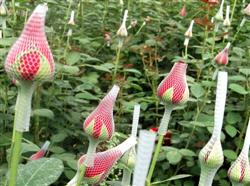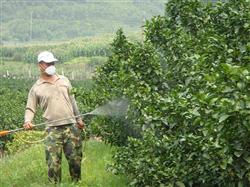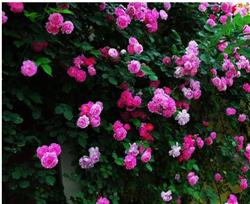How to plant roses scientifically?

How to plant roses scientifically? Please give guidance on rose planting can refer to the following methods: 1. Variety layout: Meilan lipstick and Bellamy are the main varieties in summer, and American powder can be used as summer or autumn and winter varieties. Cardinal and Hongjiu ○ are the main varieties in autumn and winter. 2. Planting period and close planting specification: the suitable planting period is from mid-April to early June in spring and from late October to mid-November in autumn. The dense planting specifications are 1.5m wide (furrow 60cm), 30cm high, 2 rows per row, 30 × 25cm between plants, and 2500 seedlings per mu. 3. Fertilization: cultivated in medium soil fertility, applying pure n35-40kg per mu p2o531.5-36kg p2o35-40kg. The ratio of n, p and k is about 1 ∶ 0.9 ∶ 1. Among them, organic fertilizer should account for more than 60%. Cardinal varieties that need a large amount of fertilizer should be applied more, while other varieties should be applied less according to the situation. 3000-3500kg is used as base fertilizer per mu, such as rotten livestock manure, human urine, mushroom material, mountain soil ash, rotten straw and so on. After heavy cutting, topdressing fertilizer, opening ditches on both sides of the border away from the root, applying organic fertilizer properly with chemical fertilizer, and combining with ploughing and soil cultivation after fertilization. Usually after cutting flowers, the method of topdressing with water can be used according to the plant production. 4. Pruning: the main varieties planted in summer, heavy cutting in winter, and the main varieties planted in autumn and winter, heavy cutting in summer. When pruning, the pruning method can be used instead of pruning for plants with few branches and weak ones. To adjust the florescence, the suitable cutting period can be calculated with reference to the accumulated temperature of the variety. Routine pruning: when cutting flowers, it should be cut at 1-2 bud points above the base of the branch, not high, to prevent the formation of hollow state. 5. Field management (1) weeding in ploughing: ploughing and weeding in sunny weather, ploughing can be combined with fertilization, and cultivate soil and repair beds. (2) drainage and irrigation: in rainy season or rainstorm, ditch drainage should be cleared in time, and irrigation should be properly diverted in dry season. The water will be cut off when the water level of the first irrigation reaches 1/3 higher than that of the border, and then the water will be cut off when the water level of irrigation is slightly higher than that of the previous one. 6. Winter heat preservation: when the night temperature is about 13 ℃ in the middle and last ten days of November, the film should be covered for heat preservation. Sunny and warm weather, when the daily temperature reaches 27 ℃, it is necessary to open the ventilation layer to cool down, and close the ventilation layer to keep warm around 4 o'clock in the afternoon. 7. Control of main diseases (1) Black spot: also known as brown spot, the pathogen is actinomycetes. The disease can occur during the whole production period, and the disease is serious in the general plum rain season and typhoon season. Prevention and treatment: clean the fallen leaves and remove the diseased leaves at any time to reduce the source of infection. The seriously diseased plants were heavily pruned in winter to remove the overwintering pathogens on the diseased stems. When the new leaves are just unfolded in summer, spray with 50% Ju Ling 500-1000 times, or 75% chlorothalonil, or 80% Dysen zinc 500 times every 7-10 days. (2) Botrytis cinerea: the pathogen is a true chrysanthemum of Hyphospora. It is easy to suffer from high temperature and poor ventilation. Prevention and treatment: remove the disease department in time, reduce the source of infection, and cut off the withered rose flowers in time. Spray with 2000 times of 50% propofol, 1000-1500 times of prohydantoin, or 500 times of methyl topiramate, once every 7-10 days, 2-3 times in a row. And pay attention to the alternate use of agents to prevent the development of drug resistance. (3) powdery mildew: the pathogen is a monofilament fungus. The disease occurs quickly in the warm and humid season. The disease is more serious when there is too much nitrogen fertilizer and insufficient potassium fertilizer in the soil. Prevention and treatment: pruning and destroying all dead susceptible branches can reduce the source of infection. Early diseased leaves should be removed as soon as possible. Spray with 20% trimethoprim EC 2000 times, or 50% polysulfide suspension, or 75% chlorothalonil, once every 7-10 days for 2-3 times. Click to get more rose planting techniques click to get more flower planting techniques
- Prev

How do crops use growth regulators?
How do crops use growth regulators? Please introduce the use of growth regulators can refer to the following methods: 1, combined with cultivation measures. Plant growth regulator is not a nutrient, it can only regulate plant growth and development, can not replace the demand for temperature, light, water, fertilizer, etc.
- Next

What method can make the rose blossom continuously?
What method can make the rose blossom continuously? Rose is a kind of flower that blooms frequently all the year round. It has a wide variety, bright colors and fragrant smell. It would be more desirable if it could blossom continuously. The monthly sex likes the growth environment with plenty of sunshine, good ventilation and fertile soil.
Related
- Fuxing push coffee new agricultural production and marketing class: lack of small-scale processing plants
- Jujube rice field leisure farm deep ploughing Yilan for five years to create a space for organic food and play
- Nongyu Farm-A trial of organic papaya for brave women with advanced technology
- Four points for attention in the prevention and control of diseases and insect pests of edible fungi
- How to add nutrient solution to Edible Fungi
- Is there any good way to control edible fungus mites?
- Open Inoculation Technology of Edible Fungi
- Is there any clever way to use fertilizer for edible fungus in winter?
- What agents are used to kill the pathogens of edible fungi in the mushroom shed?
- Rapid drying of Edible Fungi

